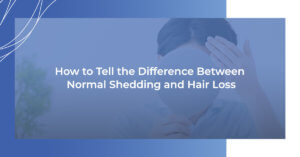
In these (and similar) circumstances, thoughts often stray to the possibility of hair loss. However, there is a difference between the amount of hair that is shed on a daily basis and excessive hair loss that can affect the volume of your hair.
How Much Hair Loss Is Normal?
The average person sheds 50-100 hairs every day. This is completely normal and has no real effect on the look of one’s hair.
When that daily number rises sharply, it indicates excessive hair shedding or (to use the medical terminology) telogen effluvium. If the scalp becomes more visible over time, that can indicate a medical condition or the genetic tendency toward androgenetic alopecia – also known as male/female pattern hair loss.
What Is the Difference Between Hair Loss and Shedding?
Hair shedding of the excessive sort is often a response to stresses that can range from workplace aggravation to recovering from an illness… among many others. The American Academy of Dermatology Association notes that (in the vast majority of cases) if the source of the stress factor is removed then the excessive shedding ceases within roughly six to nine months.
Anagen effluvium hair loss, on the other hand, is the result of something impeding or halting hair growth. Rather than being caused by temporary stresses, hair loss is often rooted in genetic predispositions, pharmaceutical side effects, and other issues. The good news is that in many cases the cause of hair loss ends up being treatable once a proper diagnosis is made.
Does Hair Grow Back After Shedding?
If it’s normal shedding, yes. Hair falls out as part of the normal growth, rest, and shedding cycle. Then it begins growing again.
If you comb your hair or accidentally pull it and notice a tiny ball or bulb on the end of the strand, don’t worry. That’s just the hair root, not the hair follicle. The hair root will grow back… assuming you don’t have any medical conditions complicating the situation.
Long Island’s Premiere Hair Restoration Facility
If you are concerned about hair shedding or hair loss, RHRLI can provide you with many options – either surgical or non-surgical – for restoring you to a full head of natural looking hair. From the ARTAS® Robotic Hair Transplant System to non-surgical therapies, we have the tools and the expertise to diagnose and treat your hair loss – regardless of cause. Contact us to arrange a free consultation today.
